
350ZR» An Unofficial
350Z Roadster Resource
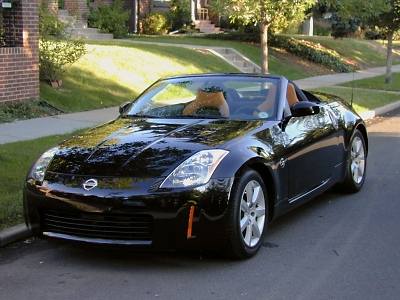
|
On 350ZR» |
"Adventure is inconvenience properly perceived." — Llewellyn Thomas
"Places to go, things to do, Porsches to pass..." — 350Z showroom banner
"Think of it as a high-performance park bench with a mechanical beauty far exceeding any external good looks." — the author
350ZR» 2004 Touring Roadster Gallery
Image categories in this gallery include...
 |
Exterior, top down |
 |
 |
At Roxborough State Park | ||||
 |
Exterior, top up |
 |
||||||
 |
Standard tires, wheels and brakes |
 |
||||||
 |
Seating |
 |
||||||
 |
Cockpit and dash |
 |
Last revised on 06/04/2005 at 21 months and 15,400 miles from purchase.
The annotated images below provide fairly complete visual coverage of our 2004 350Z touring roadster. The photos and commentary are strictly my own and in no way represent gospel or word from Nissan. However, I've drawn heavily from the wealth of user-to-user experience and knowledge to be found in the member forums at my two favorite 350Z sites, 350ZMotoring.com and 350ZFrenzy.com. If you have questions about anything you see here, I recommend cross-checking them there.
Bottom of gallery
2004 350Z Touring Roadster |
|
Exterior, top down |
|
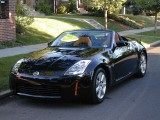 |
The exterior styling pretty much speaks for itself.
The low coefficient of drag and zero-lift front end design enhance speed,
stability and handling—three of my favorite things in a car. Good looks
don't hurt.
Of all the cars I've ever owned, five earlier Z-cars included, none has attracted so much spontaneous praise from strangers. I've had people cross the street, pull over and do U-turns to talk to me about it. The commentary is always strongly positive and sometimes effusive enough to leave me a bit embarrassed. I humbly thank all comers and usually add, "However good it may look, the mechanicals are that much better. It's a lot of fun." For more exterior views, see the Roxborough State Park and Coupe and roadster together galleries below. |
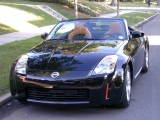 |
|
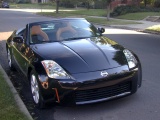 |
|
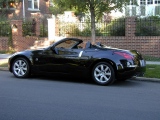 |
|
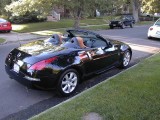 |
|
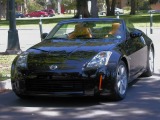 |
|
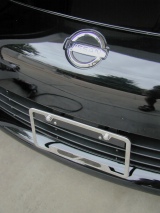 |
This
front grill detail features Nissan's Z-logo plate
holder installed via a 3rd-party Zee-Bracket.
With this setup, you don't need to drill holes in the bumper to
mount a front plate.
The rear plate's straightforward. The receptacle has threaded inserts for M6 (metric) machine screws. |
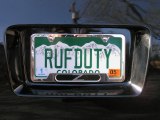 |
|
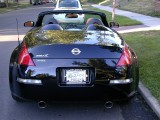 |
Porsche-eye view. |
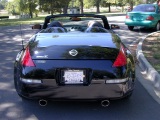 |
Compare these views with their top-up counterparts below. |
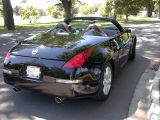 |
|
Exterior, top up |
|
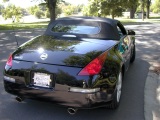 |
Based on roadster threads in a
number online Z forums, you apparently either love or hate the roadster
with the top up. I happen to like the top-up lines, but that may be partly
emotional: Open-air motoring is one of life's great pleasures in my book.
The roadster top reminds me that it can be down. After owning five
previous Zs over a 30-year span, I'd been eagerly awaiting the 350Z,
but the coupe roof line frankly left me cold. The roadster left me fresh
out of excuses.
Compare the first two frames with their top-down counterparts above. |
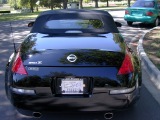 |
|
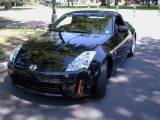 |
|
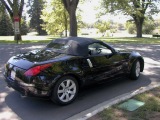 |
|
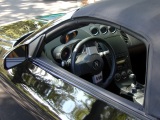 |
I consider these aftermarket inside blind-spot mirrors an essential in the roadster. |
Standard tires, wheels and brakes |
|
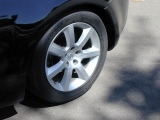 |
The standard silver-painted 7-spoke 17"
original equipment wheels
measure 7.5" wide in front and 8.0" in back. They're nice to
look at and fairly easy to clean — the latter a very good thing given the clouds of brake dust
the front rotors shed around town. For 2004, the 17" original equipment tires are still Bridgestone Potenza 040 "summer performance" gumballs measuring 225/50WR17 in front and 235/50WR17 in back. They're rather noisy, but they stick well in warm, dry weather. The standard 17" 50-series tires aren't as sexy as the 18" 40-series tire options (see, for example, the 18" Track-model wheels on the coupe below), but they're more likely to survive Denver's pot holes. When I lost a rear Potenza to a nail at ~5,500 miles, I took the opportunity to replace all four with M+S rated Michelin Pilot Sport A/S all-season tires (center frame) for better wet grip and a quieter ride. I couldn't resist the chance to examine the brake and suspension components with the wheels off. The standard 11.65" vented rotors post impressive 60-0 mph times in isolated tests, but they fade more quickly than the 12.76" Brembo rotors under the repetitive hard braking of the track. |
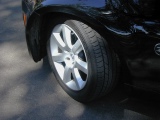 |
|
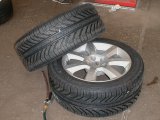 |
|
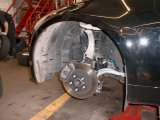 |
|
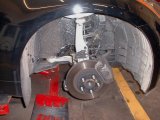 |
|
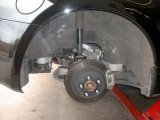 |
|
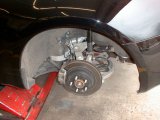 |
|
Seating |
|
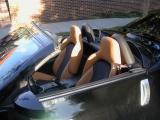 |
The ventilated seats are trimmed in
"burnt orange" leather. "Caramel" is an equally
good description of the color.
The seats are quite comfortable. Generous side bolsters hold the occupants snuggly during exuberant cornering. |
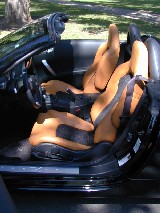 |
|
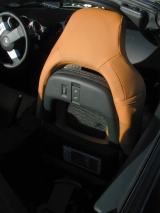
|
This passenger seat back detail reveals a large ventilation port and another set of controls for seat back operation. The large switch will tilt the seat back all the way forward with one touch but requires a constant push to return it to driving position. The smaller switch basically enables and disables the larger one. The driver's seat back has only the port. The less ventilated seat bottoms always seem warm, even with the seat heaters off. |
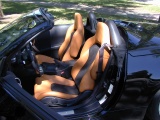 |
Ingress and egress are challenging in a tight garage but otherwise fairly easy for such a low-slung car. Just one more reason to keep the top down. |
Cockpit and Dash |
|
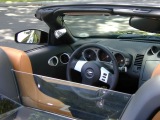 |
In these two interior overviews from the rear with the top
down, note
|
 |
|
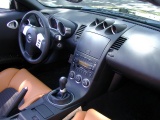 |
The uncluttered dash is simple but functional. Some complain about the 350Z's interior appointments, but something had to give to keep it under $40k. The compromise works for me, but then I've never been into flashy interiors. I'm after the mechanicals, and that's precisely what the 350Z delivers, in spades. |
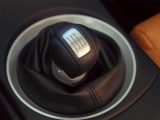 |
The crisp short-throw close-ratio 6-speed manual transmission is tight, precise and a joy to work. The gear ratios are well-chosen. |
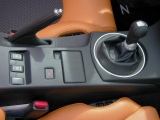 |
|
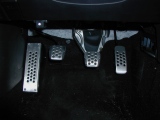 |
The drilled aluminum pedals look like they mean business. The layout is comfortable and lends itself well to a big-toe-and-pinky (as opposed to a heel-and-toe) one-foot approach to the clutch and accelerator. |
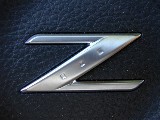 |
The steering wheel emblem nicely shows the new logo design for the 350Z line. The old Z logo with a crossbar is history. |
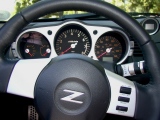 |
The main instrument cluster moves with the steering column to enhance its visibility. At night, the dash lighting is easy on the eyes in every sense. |
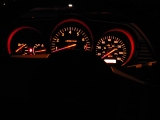 |
|
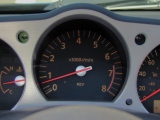 |
The turn signal indicators on either side of the big tach blink as expected, but the electronically-controlled LED turn signals, lacking the thermomechanical blinker switch of days gone by, make no sound on their own. I find the very faint synthesized blinker click barely audible—even at a standstill with the top up and the audio off. |
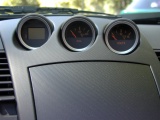 |
This Z-heritage gauge cluster harks back to the original 240Z dash. From left to right, we see here the driving computer LED display, oil pressure gauge and voltage meter. Some complain that these instruments could be more visible to the driver, but how often do you really need to check them while driving? |
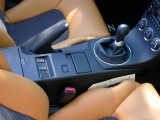 |
Functionally, the center console layout could be better, but I'm not sure Nissan had a lot of options here. The storage compartment (between the seats) isn't an easy reach for anyone. The seat heater switches (aft) sit right under my elbow when my hand is on the stick. Honey, do you smell something burning? |
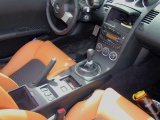 |
The three open compartments shown here account for most of the readily accessible cabin storage. Yes, I said most. |
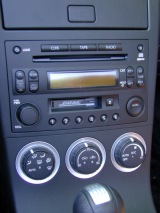 |
Three of the 350ZR's less satisfying features
reside here—the dash storage bin (top), the Bose
audio system (middle) and automatic climate
controls (bottom).
On the bright side, everything's easy to reach here, the in-dash 6-CD changer is a pleasure to operate, any extra storage is appreciated in this car, and the automatic climate control works well once you get past its counterintuitive buttonology. Follow the links above for further details. |
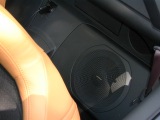 |
Chalk this 10" subwoofer up as another redeeming feature for the Bose audio system. New for 2004, it sits directly behind the driver's seat. Strong bass notes beamed directly into the driver's spine spread throughout the body from there. I have to admit, it feels good. The musical massage is a reasonable substitute for the adjustable lumbar support missing from the seat. Best of all, no quarters are required. |
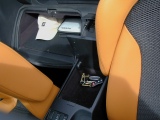 |
Nissan moved the glove box behind the passenger seat to save on production costs. It's big enough to hold boxing gloves or a full-size briefcase, it's but much less accessible than a real dash-dwelling glove box. Cabin storage is a challenge in all 350Zs, the roadster included. |
Doors |
|
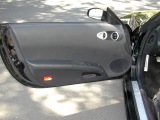 |
The vast unbroken expanse of black inside the door is another example of the first-things-first Z-car philosophy. It works for me, but a poster or two might spice it up a bit. The teensy in-door storage compartment near the bottom edge is better seen below. |
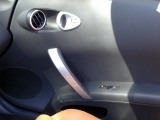 |
The door hardware is simple and functional. |
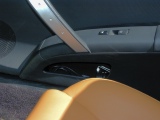 |
A close-up of the door storage pocket. The corded map/emergency light seen here pretty much fills it up. The odd shapes of the opening and the internal space exclude a lot of potentially useful items. |
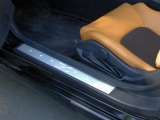 |
The optional aluminum kick plates add a classy visual accent. The lower frame shows the embossed Z-logo. Hope they last. |
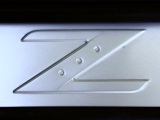 |
|
Ragtop |
|
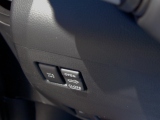 |
After
the ignition, the switch on the right in the top frame is the most
important in the car. To move the top in either direction, you have to have the engine
on, the brake pedal depressed and the roof latch open. The powered
convertible top's a complex and deftly choreographed mechanical wonder. (Think post-warranty $$$.) The dance lasts about 20 seconds, up or
down. That kind of hunker-down speed that translates directly into more
open-air driving
opportunities on iffy days.
The single sturdy silver midline latch lever (top left in the 2nd frame) operates 3 separate roof latches at once—a convenience typically found only in much more expensive ragtops. The 3 latches are visible in the 3rd frame. When the top down goes down (bottom frame), the passenger seat tilts forward slightly (presumably to alert your companion that things are about to happen overhead), the side windows drop, and the top's rear edge pulls up to allow the tonneau cover to flip open. The top's rear edge then drops again, after which the entire top disappears into the tonneau. When the tonneau cover closes, you're done. The top goes up with similar fanfare. |
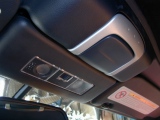 |
|
 |
|
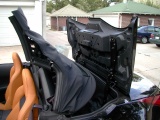 |
|
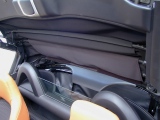 |
Rich G. asked to see the top's interior. The material and construction look to be of good quality to me, but this is my first ragtop. The top is unlined. |
Engine |
|
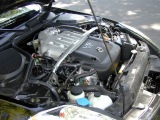 |
The venerable Nissan VQ35DET 3.5L 24-valve DOHC V-6 pretty much fills the engine bay. In the 350Z, this sophisticated V-6 is tuned for 287 bhp @ 6,200 rpm and 274 ft-lb torque @ 4,800 rpm, but it's capable of a lot more juice if coaxed with even modest modifications. Variable valve timing helps it deliver smooth power and torque at all engine speeds. |
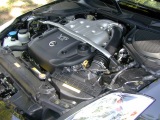 |
At first glance, there appears to be little room to spare in the engine compartment, but professional tuners don't seem to have trouble finding ways to cram in superchargers, twin-turbo kits, etc. Just add money. The rear engine bay bulkheads contribute to the admirable rigidity of the 350Z chassis. |
Trunk and spare |
|
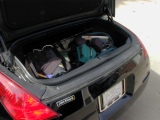 |
Two words: Pack
light. You could carry as much in a large Gucci purse, but then the purse
won't pull 0.91 lateral Gs or 0-60 in under 6 seconds. Life's an unbroken
string of trade-offs. This one works for me.
The 350Z spare tire is narrow for a reason. The spare well has enough diameter to carry a full-size flat tire when it has to, but vertical trunk space drops to about 10". The supplied tools are adequate. |
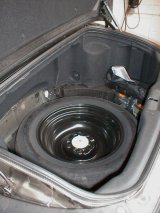 |
|
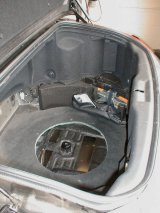 |
|
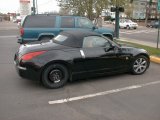 |
|
Coupe and roadster together |
|
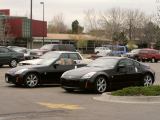
|
A glistening black 350Z coupe all by itself
at the edge of the parking lot, a camera and monopod in the trunk of my
own black (and thankfully clean) 350Z roadster, and 20 minutes to burn —
how could I resist the chance to photograph the two 350Z configurations
side by side in matching colors? The uninspiring shopping center backdrop
would hardly be noticed.
As I set up, I weighed the ethics of photographing someone else's parked car without permission. Having no way to locate the owner and seeing little harm in it, I elected to proceed, but after a few shots, someone from the nearby dental office (where I'd just dropped my son and more than a few dollars as well) came out to ask if I might be shooting a commercial. When I explained that the photos were destined for this non-commercial web site, she suggested that I come in and reassure the owner, who had spotted me from a window and was beginning to get a bit nervous about the unusual attention to her car. (Frankly, I would have been nervous, too.) Inside, I met Diana Vasquez, the coupe's owner. After hearing about 350ZR» and its purpose, she graciously allowed me to show her car — a brand new 2004 Touring model with an OEM spoiler and sharp-looking 6-spoke Track-model wheels. As you can plainly see from the shots at left, the coupe and roadster are far more alike than they are different. Can't decide which you like better? How about one of each? Thanks and happy Zing, Diana — sorry to have worried you.
|
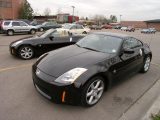
|
|
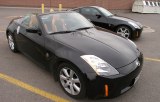
|
|
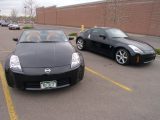
|
|
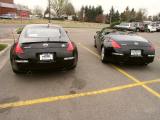
|
|
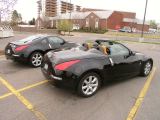
|
|
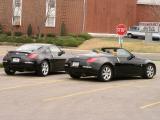
|
|
At Roxborough State Park, CO |
|
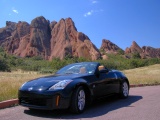 |
Forty-five minutes south southwest
of Denver is a most unusual rock garden, where towering rows of red, yellow and buff flatirons hundreds of feet
tall appear to leap from the tall prairie grass and tilt to the west as if
bowing to the setting sun. The flatirons mark the transition between the
Rockies and the High Plains. The place is Roxborough, one of the crown
jewels of the Colorado State Park system and the perfect destination on this
gorgeous September day. With the car less than 2 weeks old, I had second
thoughts about the odd mile-long stretch of gravel connecting the park
entrance to the the paved main park road, but at 5
mph, the paint collected only dust, no
dings. The photos at left were taken just before a highly recommended hike through the
flatirons on the park's main loop trail.
The 300-100 million year old sedimentary rocks at Roxborough record the coming and going of the Ancestral Rocky Mountains and the subsequent arrival of the Cretaceous Interior Seaway, a continent-scale inland sea that covered all of Colorado with 600' of water over a span of nearly 30 million years. The layers were originally laid down flat but were tilted up sharply to the west when the modern Rockies began to rise about 70 million years ago. The red rocks dominating these photos belong to the Fountain Formation, an alluvial fan deposit that also crops out spectacularly at ^ Red Rocks Park and Amphitheatre west of Denver. The buff-colored rocks in the last frame belong to the slightly younger Lyons Formation, a deposit of desert dune sands that now adorns many a Denver home, building, garden wall and walkway. Together, the Fountain and the Lyons make up the lofty rock spires seen at Garden of the Gods just west of Colorado Springs, but for my money, Roxborough's far more beautiful than Red Rocks and Garden of the Gods combined.
|
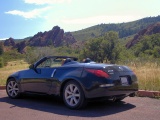 |
|
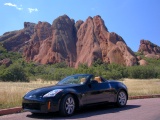 |
|
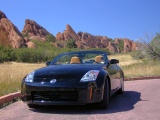 |
|
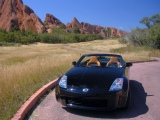 |
|
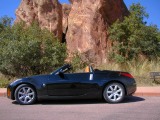 |
|
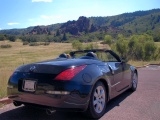 |
|
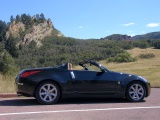 |
|
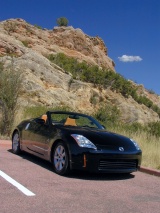 |
|